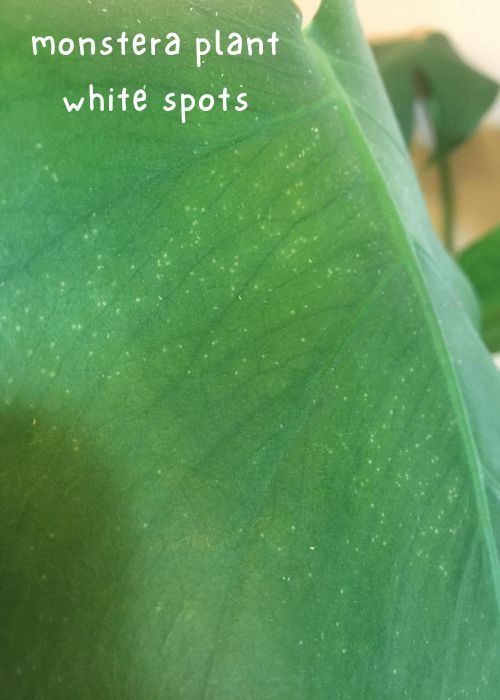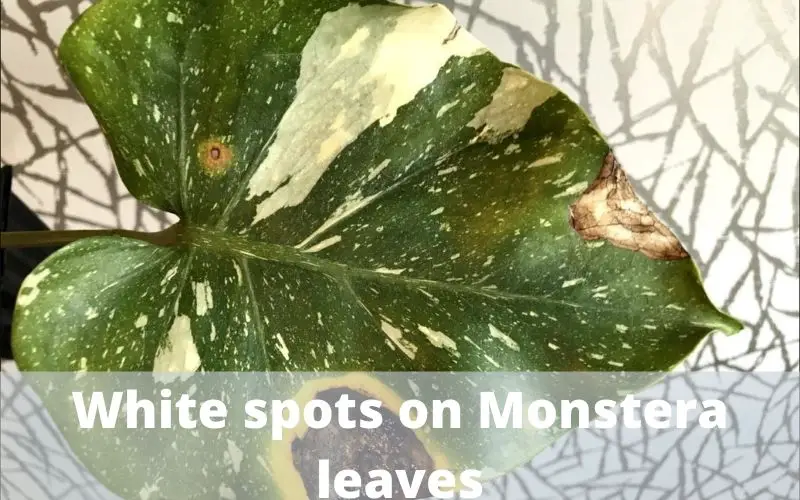When growing South American Monstera in the open air, encountering continuous rain or foggy nights. It will be drenched in the early morning, in wet conditions for dozens of hours all night and many nights in a row. It creates favorable conditions for fungal growth, causing white spots on Monstera leaves.
White spots on Monstera leaves?
White spots on Monstera Deliciosa leaf are generally caused by one of two things: either the plant is getting too much direct sunlight, or pests are damaging the leaves. If the spots are small and white, with a yellow halo around them, then it’s most likely sunscald.
Sunscald occurs when the leaves are exposed to too much direct sunlight, causing the chlorophyll to break down. If the spots are large and white, with ragged edges, then it’s probably due to caterpillars or other chewing insects. These pests can cause extensive damage to the leaves, and if left unchecked, can eventually kill the plant. The best way to prevent white spots on Monstera leaves is to provide adequate shade and to regularly inspect the leaves for signs of pests.
In addition, Monstera white spots is also caused by white stuff disease:
Causes of white spot disease
White spot disease is caused by the fungus Pseudocercosporella Capsellae, so fungus causes round leaf spots that are pale brown to yellow. Lesions are about ½ inch (1cm) across. Dark streaks and spots sometimes accompany them.
White spot disease is a relatively common and usually benign disease of fungi. Often appear after heavy rains. When meeting favorable conditions; Characteristic translucent white growth spores can be observed on leaf spots. In the fall, mold spores develop on infected plants and are then dispersed by wind and rain.

Developmental features of the disease
Small spots on leaves are often the first sign of this disease. These white stuff on Monstera Leaf are the mycelium stage and the first stage of damage. When the weather turns cold, mycelium can hibernate and overwinter in shoots or other sheltered parts of the plant or form spore structures that open in late summer or fall before winter rains.
Fungal spores can be released anytime during the growing season if favorable conditions are favorable. It is usually between 15 degrees and 26 degrees. Temperatures above 32 degrees can kill pathogenic fungi. Technically, there are many species of white spots, each of which attacks only certain plants. Most species have similar life cycles.
Related Post: How to detect bugs on Monstera? The most common insects
Treatment of white spot on Monstera trees
Therefore, to prevent this disease in South American Monstera:
- Plant it under a layer of plastic to cover the rain
- Grow it indoors to avoid rain or dew from wetting the surface of the leaves
- At the same time, limit watering to the leaves in the evening
- If planting Monstera outdoors, the tree should be placed under a layer of the net to block the sun. At the same time, it reduces the amount of night dew clinging to the surface of the leaves of Monstera. It will help reduce the rust that attacks them
- If spraying disease prevention for Monstera, use each type separately. Spray Mancozeb; next week, spray Antracol alternately
If you encounter a lot of rain or days with dew until morning, the leaves are wet, or the tree is sick: you can mix two types to increase the effect. When mixing, pour water into the bottle first and then add each drug to the stir well. Do not pour two pills directly into the first bottle simultaneously.
The right time to spray Monstera, for example, white spots is in the cool of the afternoon. When spraying, you will spray wet Monstera’s entire stem and leaves. Typically, spray insecticide to prevent leaf spot disease on trees. you will spray once every 7-10 days. Note, pour in the cool of the afternoon, in the early morning of the next day before the sun rises, your water and wash the leaves, avoiding the sun burning the leaves of Monstera.
Some other simple remedies at home
At the same time, you can do some simple remedies at home to prevent this disease from developing and use baking soda, mouthwash, and water treatment.

Treat white spots with baking soda
Baking soda alone is not usually adequate as a treatment for white spots, but when mixed with liquid soap and water. It can be a deadly weapon. Taking baking soda is used as a preventative measure rather than a treatment. Combine one tablespoon of baking soda and half a teaspoon of liquid soap; bleach-free with a gallon of water and apply it on the plant.
Treat white spot disease with mouthwash
You can use mouthwash daily to kill germs in your mouth; may also be effective in killing white spots. Three parts of water and one part of mouthwash is a good ratio but can damage the new growth because the mouthwash is powerful, so please use caution.
Treatment of white spot disease with milk
Milk is being introduced into the field to control white spots effectively. Not all science knows, but compounds in milk can act as antiseptic and fungicide and potentially increase the overall immunity of the plant. It tends to be effective as a method of preventing white spots on zucchini and other squashes and cucumbers. A compelling mixture ratio is about one part milk to two or three parts water.
Water treatment for white spots
Because of dry conditions coupled with high humidity, often the culprit behind the development of white spots, you can water the plant from above and get the whole plant wet. However, it is essential to use this method sparingly, as overwatering can cause other problems for your plants.
Besides, after combining many measures to treat these Monstera white spots on leaves, roots, and stems, you need to incorporate healthy Monstera plant care by ensuring the plant’s right light, temperature, humidity, and water. If white spot disease is severe, you need to change the soil to help the plant get healthy faster and avoid re-infestation.



